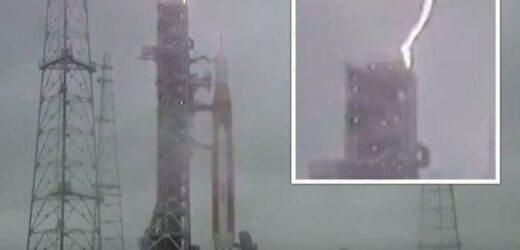Lightning hits new NASA rocket at the heart of new moon mission
We use your sign-up to provide content in ways you’ve consented to and to improve our understanding of you. This may include adverts from us and 3rd parties based on our understanding. You can unsubscribe at any time. More info
Artemis I is to be the first launch of NASA’s long-delayed, 322 feet tall Mega Moon Rocket — officially the “Space Launch System” (SLS) — as well as the first in an increasingly complex series of missions aiming to return humans to the Moon for the first time since 1972’s Apollo 17. The launch, which will take place no earlier than May this year, will transport an uncrewed Orion capsule into space for a 20–25 day journey looping repeatedly around the Moon. The craft — which will carry three radiation measuring “phantoms”, including two female torsos and one life-size male manikin — will pass as close to the lunar surface as 62 miles, but also journey out some 40,000 miles beyond the Moon before it returns to Earth to splash down in the Pacific Ocean near California.
Assuming Artemis I proves successful, this year’s mission will be followed up by Artemis II in around May 2024, which will carry a four-person crew more than 5,523 miles beyond the Moon — further than any human has ever been from the Earth — on an eight–10 day flight test.
Building on this, no earlier than 2025, the Artemis III mission will see four astronauts travel in an Orion capsule to the planned Lunar Gateway space station in the Moon’s orbit, spending a total of 30 days in space.
Two of these explorers — including the first woman and person of colour to walk on the Moon — will be carried down to the lunar surface by the Gateway’s “human landing system”.
They will spend a week exploring the surface of the Moon’s South Pole — a region previously unvisited by humans — conducting various experiments including the sampling of the water ice that was first detected on the lunar surface back in 1971.


The “wet dress rehearsal” — which gets its name because it involves a complete run-through of all the SLS’s launch procedures, including filling the rocket’s tanks with 700,000 gallons of super-cooled propellant — involves a 45-hour test countdown that began late last Friday afternoon.
On Saturday, NASA engineers confirmed that four discharges struck lightning conductors within the perimeter of the SLS’s launch pad.
The pad’s lightning protection system, NASA explained, comprises three nearly 600-feet-tall towers that attract bolts away from the rocket itself.
In a statement issued on Saturday, NASA said: “Teams have determined the first three were low-intensity strikes to tower two and are continuing to review data from the fourth strike, which was higher in intensity to tower one.


NASA continued: “At the time of the strikes, Orion and the Space Launch System (SLS) core stage were powered up and the solid rocket boosters and interim cryogenic propulsion stage (ICPS) were not.”
“Teams currently see no constraints to proceeding with the test countdown timeline as planned and will continue procedures to power up the SLS boosters and ICPS overnight.
“Overnight, engineers will also work to make up time for activities that were paused due to the severe weather.
“The Mission Management Team will review the schedule and data from the power-ups and sensors at the pad at 6 a.m. EDT tanking meeting before making the decision to proceed with the test.”
DON’T MISS:
Germany backs down and REFUSES to cut energy ties with Russia [INSIGHT]
Covid may cause brain damage even with only mild respiratory symptoms [ANALYSIS]
NASA astronaut to take artificial meat experiment to ISS next week [REPORT]

While the lightning may have only slightly delayed the progress of the wet dress rehearsal, engineers were forced to cease the tests on Sunday, prior to filling the rocket’s tanks, following an issue with the fans that pressurise the mobile launcher.
NASA explained: “The fans are needed to provide positive pressure to the enclosed areas within the mobile launcher and keep out hazardous gases.
“Without this capability, technicians were unable to safely proceed with remotely loading the propellants into the rocket’s core stage and interim cryogenic propulsion stage.”
Tests were resumed yesterday but ultimately called off at 5pm local time, after both hours of delay spent troubleshooting a temperature issue with the cryogenic liquid oxygen propellant — which is kept at a nippy -297F (-183C) — followed by a problem with a vent valve used to relieve pressure from the core stage during fuelling.
NASA said: “Given the time to resolve the issue as teams were nearing the end of their shifts, the launch director made the call to stop the test for the day.
“A crew will investigate the issue at the pad, and the team will review range availability and the time needed to turn systems around before making a determination on the path forward.”
Source: Read Full Article


